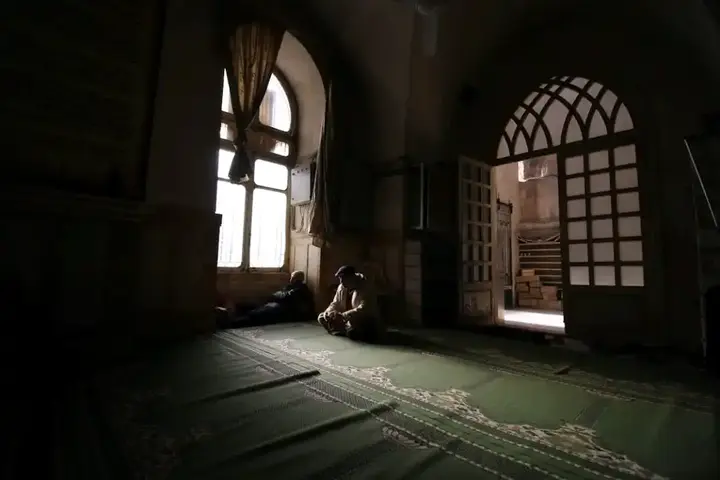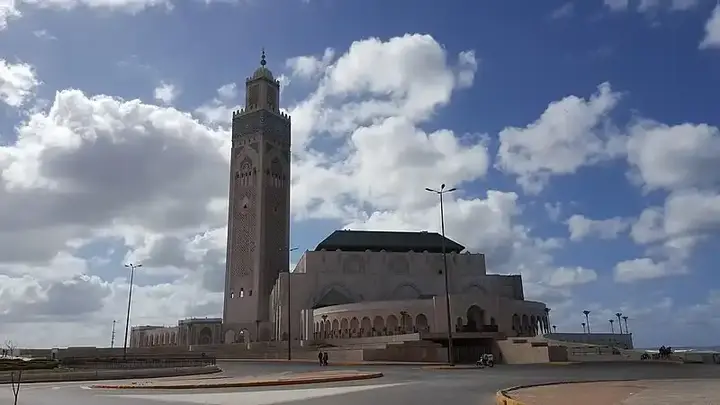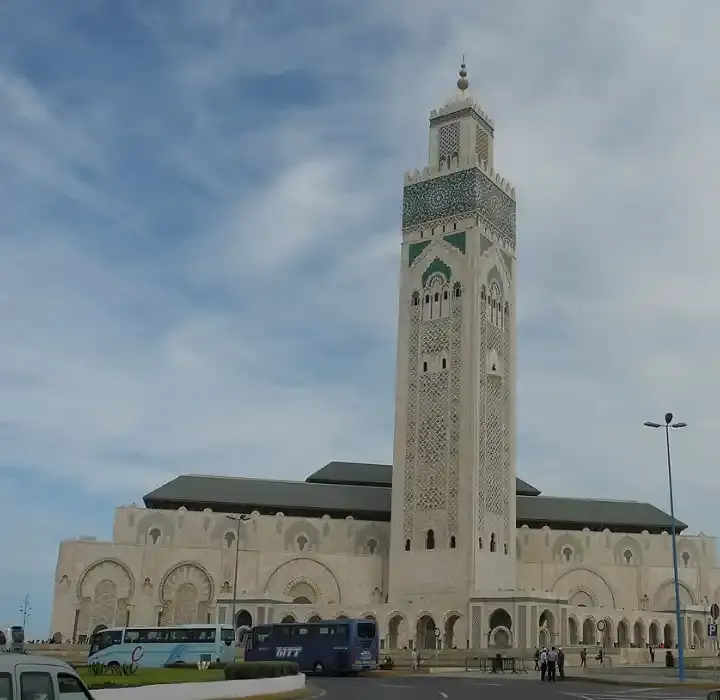Morocco's largest mosque, King Hassan II Mosque in Casablanca
Morocco's economic capital, Casablanca, is famous for many, but the most prominent is the King Hassan II Mosque. It is the largest mosque in Morocco, the second largest in the continent of Africa and not to mention being the first mosque overlooking the Atlantic Ocean and its high-rise minaret. It was built by 2,500 workers and 10,000 traditional craftsmen, in addition to being supervised by King Hassan II himself, and designed one of its domes, which was used for the first time in Moroccan mosques.
Show key points
- The King Hassan II Mosque in Casablanca is the largest in Morocco and Africa's second-largest, uniquely positioned overlooking the Atlantic Ocean.
- The mosque was designed by French architect Michel Bensau, who extensively studied Moroccan-Islamic architecture and blended traditional influences with modern features.
- Built by 2,500 workers and 10,000 artisans, the mosque showcases a meticulous level of craftsmanship and was personally supervised by King Hassan II.
- ADVERTISEMENT
- A major engineering challenge was constructing part of the mosque over the sea, requiring advanced materials like titanium-coated doors and moisture-resistant "Tadlakt".
- The 200-meter-high minaret, among the tallest in the world, includes a lighthouse and a 30-kilometer laser beam guiding ships into Casablanca’s port.
- Architectural elements blend Andalusian and Moroccan styles, evident in features like the prayer hall with a movable ceiling, domes shaped like roses, and elaborate decorative details.
- The mosque's use of materials such as Murano glass, alabaster, marble, and carved wood reflects a harmonious combination of technology, tradition, and artistry in Islamic architecture.
Design of King Hassan II Mosque

The Hassan II Mosque was designed by the French architect Michel Bensau, who was brought to Morocco by the king, to work on several designs, including this mosque. Designed on a historical structure and based on contemporary architecture, Benso followed years studying Moroccan Islamic architecture where he lived in Casablanca for more than 20 years. His inspiration was the Koutoubia Mosque in Marrakech, the old part of the Hassan Mosque in Rabat, as well as the Great Mosque of Seville.
Recommend
Designed on a total area of 90 square meters, the mosque was a mixture of ancient Andalusian designs, integrating a Moroccan style with modern design features, keeping pace with developments in historical buildings globally. This mosque was built on two sides, the first side from the land side, consisting of an entrance decorated with ornate doors and carved arches indicating historical connotations, and the second in the middle of the water.
One of the challenges facing the construction was the burial and backfilling of 15 hectares of sea space through the use of highly resistant and rigid materials, concerned with the durability of the building and its stability above the waves, such as travertine and titanium coating for doors, and "Tadlakt" (a type of waterproof dyes famous in Moroccan architecture), a material against moisture. The construction also required nearly 300,000 cubic meters of concrete and 40,000 tons of steel.
Design of the minaret of the King Hassan II Mosque

The design of the minaret has a Moroccan-Andalusian architectural character, oriented towards the qibla in a corner direction, unlike the rest of the mosques in the Islamic world, whose sides were built in the direction of the qibla. The minaret rises 200 meters, making it one of the highest religious monuments in the world, and it is equipped with a lighthouse, and a jamour of 3 golden balls with a height of 15.5 meters, in addition to that it radiates a laser beam with a range of 30 kilometers, and it is a beacon for ships coming to the port of Casablanca.
During his visit to the site, the king had asked the responsible company to raise the minaret an additional 25 meters after noticing that its size was not commensurate with the size of the building, which required the development of building materials to be able to withstand this additional weight following this modification. As for the facades of the minaret, they are decorated with ornate figures of Rodani limestone, and with a mosaic green glass paste, made of titanium, on stainless steel frames. With a base area of 625 square meters, there is an elevator for 12 people, which enables them to reach the top of the minaret in less than a minute, which is great work!
The architectural style of the mosque

The mosque embodied the characteristics of Arab-Islamic architecture, in terms of form, decoration, size and location, and its architecture was inspired by the cultural richness of Moroccan building art over the centuries. He revived the Andalusian heritage, while preserving the Moroccan architectural form. One of the most important points that reflect this style is the focus on the prayer hall (prayer hall or mosque nave) in proportion to the area of the mosque, because it is the source of light and air for the rest of its parts.
The prayer hall is located on an area of two hectares, and can accommodate 25,000 worshippers, in addition to another 80,000 in the outdoor courtyard. The hall is topped by a 60-meter-high movable ceiling, which opens and closes automatically in 5 minutes to see a sunny courtyard similar to the old buildings with Arab-Andalusian architecture. There are also Murano chandeliers, glass doors on the north wall, a collection of sumptuous alabaster deaconesses, as well as 3 openings made in an arched wooden frame.
Moreover, the courtyard of the mosque is equipped with a heated floor covered with marble, granite and limestone, which makes it mimicking the décor of Moroccan carpets, and is decorated with "Stenia" domes and domes in the shape of a rose, called "Hassaniya" whose design was supervised by the king himself, so it was the first domes used in Moroccan mosques, which are carved wood and installed on frames weighing 971 tons of stainless steel and suspended from a concrete structure. The mosque is also characterized by the height of its columns of 13 meters, and its diversity in form and craftsmanship, where we find an aesthetic employment of calligraphy and decoration of wood, gypsum, copper, marble, mosaics and dyes of different colors,








